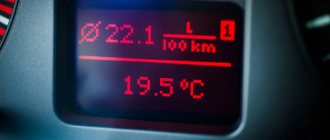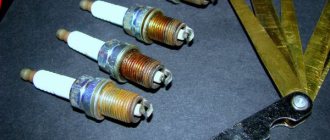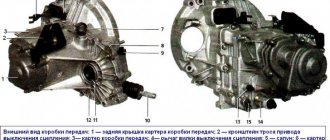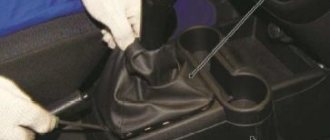Operating principle and differences between buttons
The 1-2 generation button on the carburetor has two working positions and one neutral.
- I – the engine starts and runs only on gasoline (gas valve is closed, the red light is on).
- II – The internal combustion engine switches to gas, while the gasoline electric valve closes and the green lamp lights up.
- 0 (Neutral) – serves to burn gasoline from the carburetor float chamber.
Changing the fuel type should only occur through the neutral position. If you turn on the gas right away, two types of fuel will enter the combustion chambers and the engine will most likely stall.
Some copies have an indication of the fuel level in the cylinder, as well as an additional button for the pre-start supply of a portion of gas, which is needed to enrich the mixture when starting a warm engine on gas (for example, Lovato, Logo buttons for a vacuum reducer).
A key such as, for example, Stag 2-G already has a pre-start function built into it, with the ability to adjust by time.
In the injection version, instead of the middle position, there is an automatic mode (on some types, such as Stag 2-W, it can be extreme). In this position, the engine starts on gasoline, and when a certain engine speed is reached, the gas supply is automatically turned on.
The transition speed is regulated using a potentiometer on the side surface of the housing. This key can also come with a level indication.
The universal option involves installing a toggle switch on both the injector and the carburetor. The transition between modes is carried out using a jumper/jumper on the case (example SVG switch).
The 4th generation HBO button has an LED indication and 2 operating modes on/off. In the on position, the gas turns on automatically after the reducer-evaporator warms up to 35-45˚C. The temperature is programmed in the controller when setting up the equipment.
Button signals using Stag as an example:
- LED is on/off – the engine is running on gas/gasoline;
- blinks at intervals of 1 second. – the engine is not warmed up;
- flashes every 2 seconds – the system is ready to switch to gas;
- blinks every 4 seconds – the tank has run out of fuel;
- the buzzer beeps three times - the system switches from gas to gasoline due to lack of fuel;
- three short signals 1 long – ECU (control unit) error;
- two short beeps 1 long beep (with the ignition off) – maintenance of gas equipment is required.
In addition, the fourth version of the gas system has an emergency start on gas. The mode is activated as follows: hold the button with the ignition off until the LED lights up continuously. Then, without releasing the key, we start the engine. Deactivation occurs after stopping the internal combustion engine.
Types of buttons (video):
Selection table (with approximate prices):
| Name/labeling | injector/carburetor/generation | Level indication, +/- | Price in rubles |
| REG OMVL Dream XXI King | engineer/4 | + | 1020 |
| Logo 145 | engineer/4 | — | 280 |
| Logo 101 | carb./1.2 | — | 470 |
| Atiker (K01.003.000.020) | carb./1.2 | + | 600 |
| Stag 2-G | carb./1.2 | — | 550 |
| AEB 722 | carb./1.2 | + | 1050 |
| Tamona K-5 | carb./1.2 | — | 520 |
| Lovato | carb./1.2 | — | 590 |
| Torelli | carb./1.2 | + | 630 |
| Stag 2-W | engineer/2 | — | 600 |
| Tamona in-3 | engineer/2 | — | 540 |
| Stag LED-401 | engineer/4 | + | 750 |
| Stag LED-300 | engineer/4 | + | 580 |
amega267 › Blog › HBO OMVL (OMVL) Saver control description.
In general, I installed this kit on my car.
I've already driven 1100 km. So far the flight is normal and I haven’t felt any difference between gas and gasoline. I created this topic because... After installation, the guys did not receive proper and complete information about what and what indicator means on the LPG control button, and they also did not explain what and how it works. Just in a nutshell. Also, this information is not available on the Internet. So I will get to know this system more deeply and at the same time post everything here. I'll start with a description of the control button.
My button is like this
Next, what do the indicators mean and the color of the indicators?
So we started: in the center there is a button to turn on/off the HBO. Each action is accompanied by a beeping buzzer. Its volume level can be adjusted programmatically. Next are the indicators (I’ll start out of order): 3. This is a photosensor. It determines the level of illumination in the interior and, based on its readings, the HBO system selects the brightness of the remaining diodes. 2. Three green diodes. Indicate the gas level in the cylinder when the system is working properly. When the gas tank is full, all three light up, then as the gas in the tank is consumed, they go out one at a time from right to left. 1. Red LED. Indicates the minimum gas level in the cylinder if it lights up continuously. If it flashes, it means that there is low gas pressure at the reducer. (occurs at the moment when the gas has already run out in the cylinder or the reducer is damaged) 4. Red diode. When it blinks, it means that the system is in emergency mode and the HBO is not working. Usually flashes together with one of diodes 1 and 2 indicating the error number of the HBO system malfunction. 5. Blue LED. Indicates that the car's engine runs on gas. Programmed by default. During this time it glows continuously. If it blinks, then read on.
During a cold start of an engine (ICE) running on gasoline, the LPG starts and begins to wait for the gearbox to warm up to the set coolant temperature to switch from gasoline to gas. As a rule, the transition temperature is 35-45 degrees Celsius. At the same time, blue indicator 5 and indicators 1, 2 begin to pulsate. During warming up, as the transition temperature is reached, indicators 1 and 2 will not all flash at once, but will be added in turn from left to right, and as soon as all four (1 and 2) flash together with the blue indicator, this means that the coolant temperature for transition to operation on gas achieved and the system will automatically switch the internal combustion engine to gas operation.
Next, you can programmatically select which of indicators 4 or 5 will indicate operation on gas. Or you can turn off both indicators.
The emergency start procedure on gas is carried out as follows: 1. The temperature of the gearbox must be greater than 0 ˚ C 2. Turn on the ignition 3. Set the switch to the gasoline position 4. Turn off the ignition 5. Turn on the ignition 6. Press and hold the button on the switch for approximately 10 seconds The LED will flash and a continuous beep will sound. The gas ECU will open the gas valve and the LED on the switch will be on continuously. (If you hold the button for another 5-10 seconds, you will enter the fuel level sensor calibration mode and diodes 1,2 will start blinking alternately.) 7. Turn the key to start and start the engine. The maximum number of emergency starts is 50. You can check the number of emergency starts performed in the diagnostics.
Gas level sensor calibration mode. The gas cylinder must be empty for calibration. Next, carry out steps 2 to 6 as during an emergency start on gas. When the diodes begin to blink alternately, turn off the ignition and remove the key. Let's go fill the tank until it's full. 7. After refueling, insert the key and turn it to the ON position, but do not start the engine. The LEDs will start blinking again for about five seconds. All calibration is completed and the engine can be started.
LIST OF ERROR CODES Each error has its own individual digital code, which can be displayed on the switch using one red and three green LEDs. The corresponding function is activated in the configuration window.
Now I’ll touch the diagnostic connector.
Pinout and appearance as in the photo. (the photo is not mine. I was too lazy to take my own because it’s available on the Internet).
Colors of wires on the reverse side: +12V - red RX - white TX - green GND - black The only thing I will add is that there is no need to purchase an expensive cable for diagnostics for 1200 rubles. You can simply buy a ready-made assembly (100-200 rubles) or take a ready-made construction kit or even solder it yourself. In this case, the well-known PL2303HX or FTDI ft232rl are used. the price of their pennies. The firewood for them comes immediately sewn into the program for setting up the HBO. And upon completion of the installation of the program, it is possible to supply firewood for one or another chip. This is what the assembly looks like at a cost of about 100 rubles.
All you have to do is solder GND to its outputs; RX and TX three wires and plug them into the connector above as described. You can also configure other types of HBO.
Also, whoever has an ELM327 USB adapter uses the same chips in its depths. And accordingly, you can solder the wires where you need to adapt it to work on setting up and diagnosing the gas equipment and not have any costs other than the cost of three wires.
A program for diagnosing and configuring HBO is available on the Internet. Downloading it will not be difficult because... All stores selling gas equipment and spare parts for them offer it for download, so I won’t post links here. The file name looks like this: SAVER-4.0.7.0-setup
The only point: visits to HBO by third-party computers are recorded by HBO’s brains. There, computers are registered and an identification number is assigned to them. If your installation is still under warranty and you want to maintain this warranty, then you should not connect.
If there is no guarantee or you are going to set everything up yourself, then go ahead. A description of the settings is available directly in the program itself in PDF format. That's all for now, but I think I'll continue.
It's already been a year and 33,000 runs under my belt. Everything works fine so far except for one small thing. The thermistor in the pressure reducer, which shows the temperature of the reducer, has died. I didn’t buy a new one like this (for 250 rubles) because... there is an ordinary small-sized thermistor at 2.2; 4.7 or 10Kom. I bought three pieces on the radio market for 10 rubles 10 k. I picked out the body of the old one, cleaned everything, added a little KTP8 thermal paste to the beginning and filled the rest with epoxy. It began to work much faster and in the summer the car switches to gas after just 5 minutes of engine operation. And before the replacement it switched to about 75 °C.
And now three years have passed. Replaced all low pressure gas hoses with new ones. The old ones were already a little frayed and saturated with odorant. This caused the smell of gas to appear from under the hood. Now everything is in a bundle again.
Source: www.drive2.ru
Connection diagram of the 2nd generation HBO button to the injector
Installing and connecting the 2nd generation HBO button with your own hands on a car with an injector sometimes causes difficulty.
In fact, everything is much simpler than it seems. The factory instructions for installing the switch indicate the following pinout:
- the white wire should go to the level sensor on the multivalve (if such an indicator is installed);
- yellow goes to the positive of the gasoline valve (if there is emulation of gasoline injectors, this wire is not connected);
- blue connects to the positive terminals of the gas valves of the reducer and the additional remote valve with filter. The injector emulator also cuts into this circuit;
- red goes to the positive terminal of the ignition coil (necessarily with a fuse);
- black - mass;
- brown to the negative terminal of the coil.
It’s hard to disagree with the first three points. But for the rest we will make recommendations:
- The red wire is best connected to the positive side of the ignition switch. Because the coils may have voltage surges. In order not to disassemble the panel, the contact can be found on the fuse block.
- The black wire should only be attached to the car body, like all negative equipment cables.
- Brown, must be wound onto the central high voltage wire of the coil.
It is advisable to do 10-15 turns, without using electrical tape. The electrical tape dries out over time and falls off; it is better to make a knot similar to tying a fish hook.
If the ignition system consists of separate coils, it is necessary to wind the wire onto the first two armor wires (for a more accurate signal), without breaking the brown one, i.e. first to the first then to the second.
After connecting the button, it must be adjusted. Periodically increasing the engine speed with the accelerator, it is necessary to smoothly turn the potentiometer screw clockwise and back. It is necessary to ensure that the gas supply is turned on in the “automatic” mode when the tachometer reading is 2000-2500 rpm.
Connection diagram of the 2nd generation HBO button to the carburetor
For a carburetor engine, the connection looks similar:
- Red - through the fuse to the ignition coil/switch.
- Light blue (blue) – gas valve positive.
- Yellow – positive of the gasoline valve.
- Black – minus (car body).
- The brown one goes to the ignition coil armored wire. It is needed to transmit an impulse to the key, which determines whether the motor is running or not.
If you still have questions about connecting or selecting buttons on the HBO, ask them in the comments. We will be happy to answer them.
Source
HBO button 2nd generation
Sometimes owners of cars with gas equipment need to change or independently connect the 2nd generation LPG button. Today we will talk about the difference between the gas-gasoline switch for injection and carburetor engines, and we will also provide a diagram for connecting the LPG button.
There are two most common types of fuel switches, which visually differ in practically nothing except the index. One is intended for a carburetor, the second for an injection power unit.
HBO button for injection engine
The button for switching the 2nd generation LPG to the injector has the index “W” and slightly modified wiring.
The LPG fuel type switch has 3 positions:
- Gasoline only (in this operating mode, the engine runs exclusively on gasoline, the indicator light does not light up or glows red);
- Gas only (this emergency mode is designed to start the engine on gas without pre-warming on gasoline, the indicator lights will flash in this operating mode)
- Automatic (when this operating mode is selected, the car starts in normal mode on gasoline, and when a given number of revolutions is reached, it switches to gas. The display shows the level of gas in the cylinder).
Setting up the 2nd generation HBO button for the injector
The functionality of the switch for an injection internal combustion engine includes:
- indication,
- Built-in emulator with time delay,
- The ability to regulate the number of revolutions at which the engine automatically switches from gasoline to gas.
For automatic operation of the car, you must correctly configure the LPG button, in particular, set the required number of revolutions at which the engine operating mode will change.
The adjustment occurs by rotating the potentiometer clockwise or counterclockwise, which is located directly on the device itself. The optimal speed is considered to be from 1500 to 2500.
Depending on the time of year and weather conditions, the number of revolutions can be changed:
- set lower speeds for the summer period
- higher for winter, so that switching to gas does not occur when the engine is not warmed up.
The button is supplied with:
- A set of wires for connecting to HBO.
- Plastic mounting bracket for attaching the device to a car dashboard or other convenient place.
- Mounting terminals for connecting power supply devices (reducer valve, emulator, etc.).
- Fuse and power cord.
HBO control button
The control button, or switch for the HBO mode, is made in the form of a small side with a two-position switch, which has a common bus and two outer ones. The gas indication is blue or green, while for gasoline the switch glows yellow, orange or red.
Despite the undeniable advantages - the relative low cost of refueling a car, up to ten times cleaner exhaust and concern for the environment, much less frequent maintenance and repair of engines - gas equipment also has weaknesses, and one of these “bottlenecks” - a button or switch that allows the car to switch from gasoline “ration” to gas and back. The button can be mounted either next to the instrument panel, or next to the pedals, or in another convenient place.
LPG carburetor button
The fuel type switch for a carburized car has the index “G” and three positions:
- I – operating mode on gasoline only. In this operating mode, the gasoline pump is activated, and all gas equipment is turned off;
- 0 – operating mode in which both power supply systems are disabled. Allows you to exhaust the contents of the carburetor float chamber before switching to gas. This operating mode is necessary to prevent the internal combustion engine from flooding with two types of fuel at the same time.
- II – gas only operating mode. The car starts and runs exclusively on gas; the fuel supply to the gasoline pump is not used. During the spring-summer period of the year, you can operate a car without gasoline at all.
The front panel of the device has LED indicators that indicate what fuel the car is currently running on.
On the side panel of the device there is a potentiometer that regulates the gas supply time. If the engine for some reason does not work or does not start during this period of time, the gas supply is stopped automatically.
Most gas-gasoline switch buttons are additionally equipped with an indication of the amount of gas remaining in the cylinder.
NAGAZU.RU › Blog › The switch used in 4th generation HBO systems has two positions
The switch used in 4th generation HBO systems has two positions:
— Position “Gasoline”, — Position “GAS”.
Switching from gasoline to gas When driving on gasoline, we set the switch to the “gas” position (by pressing a button). The LED indicator lights up when running on gasoline, and the LED indicator for gas blinks at this time. After reaching the required parameters (gearbox temperature, engine speed), the solenoid valve opens and the electronic control unit turns off the power to the gasoline injectors and redirects the modified control impulses from the gasoline injectors to the gas ones - the engine runs on gas (the indicator for gasoline goes out and the LED indicator stops blinking and lights up constantly ). In different versions of the switch, the method of signaling individual phases of operation of gas equipment (LED lighting) may be different.
HBO button connection diagram
Let's look at the connection diagram for the 2nd generation HBO button for an injection-driven internal combustion engine using the example of a product from the manufacturer stag2 and Digitronic.
It should be noted right away that the basic functionality and connection method itself are the same for almost all manufacturers. The recommended connection diagram must necessarily be included with the HBO switch. The connection diagram for the 2nd generation HBO button to the carburetor will have a similar appearance.
The wire set for stag2 and Digitronic products has the following colors:
- White . It is connected to the gas level sensor in the cylinder and is responsible for the correct indication on the fuel level button in the cylinder.
- Cyan (blue) . It is connected to an electromagnetic gas valve , which is located on the reducer. When the device is switched to the “Gas” operating mode, the gas valve opens and gas is supplied to the reducer. An additional gas valve with a filter and an injector emulator can be connected in parallel to the same wire.
- Yellow . Connects to the solenoid valve in front of the gasoline pump . When the button is in the “gasoline” position, power is supplied to the gasoline solenoid valve and the car runs on its native fuel. When the car switches to the “gas” operating mode, no power is supplied and the fuel pump does not work. Many installers of gas equipment do not recommend turning off the gas pump, but insist that it works even when the vehicle is running on gas.
- Red . Power supply for the HBO button . You can connect directly to the positive terminal of the battery through the fuse and boot for it included in the kit. In this case, the HBO switch will be under constant voltage. If you want to power the gas-gasoline switch only when the ignition is turned on, you should take 12 volts from another place (for example, power supply to gasoline injectors).
- Black . Ground , needs to be connected to the car body.
- Brown . Connects to the control contact on the ignition coil. From here, information about the number of engine revolutions is taken and, accordingly, gas-gasoline operation is automatically switched. In the case of a carburetor engine, a signal is taken from here whether the engine is running or not; if the engine is turned off, no fuel is supplied.
Source
see also
Comments 30
What exactly are these “brains”? How can I find out which button I'm talking about here? There are many buttons on the 4th generation and they are not interchangeable.
Switch button in the cabin. Already figured it out
But is there a switch button on 4? Maybe I don’t know?
Of course it's worth it. It’s just that the 4th generation also switches to gas itself, and the 2nd in the river version.
but 2 also has an automatic and it also drives itself
And you thought that in the 4th generation everything is somehow done by itself... there are just different buttons...
of course it’s 4 that’s why they refuse it that you can’t switch som
Everything is possible... just different generations of LPG, for different cars
I also didn’t know that 2 also has an automatic transmission and it itself also switches the car to gas... But I knew for sure that our gearboxes are not interchangeable, that you have a “greed screw”, and our tuners do this through a computer...
I just took the car for volume 4 and it turned out to be volume 2. good luck to you and stay healthy!
The first stage has been completed (fuse) it’s time to move on to the second (laptop, lanyard, program)… Post screenshots of the program, otherwise we don’t even know what’s behind HBO 4… We’re not psychics. (Audi 100 v6, you didn’t have to write, we you guessed it, since this is your only car). Usually, if the fuse is on, look for the short one...
Or could it be due to the solenoid valve on the gearbox? It turns out that gas is not flowing, I removed the filter, opened the bottle, gas does not flow, it seems like the valve is not allowing it to work.
Agree. That's why I asked about what equipment was installed. I can programmatically see “whether the electric valve is commanded to open” and much more, and from here there are different ways to troubleshoot.
I don’t have the program and I don’t have a lanyard. My brains are Omvl, my gearbox is evropagaz. Should I try buying and replacing the valve? Or should I look for gas workers tomorrow?!
Read also: Lada Vesta Sport up to 100
If you don’t have any of this, then there is a third option. wallet and to the gas workers. There’s still nothing to set it up with... What’s all the talk about... If you get tired of feeding them, you’ll buy them and master them...
I don’t have the program and I don’t have a lanyard. My brains are Omvl, my gearbox is evropagaz. Should I try buying and replacing the valve? Or should I look for gas workers tomorrow?!
And who previously, before the breakdown, serviced the gas equipment? Go to them...
Or could it be due to the solenoid valve on the gearbox? It turns out that gas is not flowing, I removed the filter, opened the bottle, gas does not flow, it seems like the valve is not allowing it to work.
To check the valve: 1) remove the chips from it and measure the resistance... 2) maybe it is jammed and does not open: remove the hose in front of the vapor phase filter and, without turning on the gas pump, give it +12v and ground (just do not confuse the polarity). Then there will be or gearbox or cartoon in a balloon...
Whoever serves can only do it in the middle of the week, and I’m leaving on a business trip. So I need it tomorrow, I’ll look for others. My wife just drove, started it, stalled when switching and the fuse blew. I replaced it, now the horseradish switches to gas. Everything happened suddenly. Today I changed the filter, I thought suddenly they had clogged up, the mileage on them had just reached 10t.km. In short, you need to connect the beech, that’s the only way.
To check the valve: 1) remove the chips from it and measure the resistance... 2) maybe it is jammed and does not open: remove the hose in front of the vapor phase filter and, without turning on the gas pump, give it +12v and ground (just do not confuse the polarity). Then there will be or gearbox or cartoon in a balloon...
The problem turned out to be the valve solenoid. I installed a new one and everything is fine
When accelerating, the system switches to gasoline. When you press the button again, the system starts until the next increase in speed and turns off again.
6. The car lost throttle response and became more sluggish during acceleration.
11. Does not start on gasoline (for 2nd generation)
Check the reducer for gas leaks into the intake manifold. Replace the gearbox repair kit. Check the injectors for gas leaks into the manifold. Replace injectors or repair. Replace the vacuum line hoses if cracks are suspected.
13
. Unstable idle. High fuel consumption. (for 2nd generation)
14
. In cold weather of -15 the car stalls when switching to gas.
15
. If you have an external cylinder. IMPORTANT! (and there is a gas level sensor on the cylinder)
What is included in the 2nd generation HBO kit
— Gas reducer, for example the most common Tomasetto Alaska
— Mixer with anti-cotton valve
Which is installed in front of the throttle valve, so that the gate inside is closed when the engine is off
— gas-gasoline fuel switch button (for an injector), do not confuse it with the switch for carburetor engines, there is a difference in the power supply on the yellow wire.
— antifreeze tees for inserting gearbox heating into the interior heater line;
— power register (mechanical) in contrast to the 3rd generation, where an electronic one is installed;
— a cylinder with a Euro standard multi-valve (automatic shut-off of the cylinder while driving on gasoline or with the car turned off);
— emulator of gasoline injectors. Read the article about connecting an injector emulator to HBO 2;
— the line that goes from the cylinder to the reducer and the VSU; — remote filling device;
Spontaneous switching from gas to gasoline and back, reasons:
- First of all, I would recommend starting small - checking and, if necessary, replacing the filter, namely the coarse filter, which is located in the gearbox. If the filter is clogged, the gas supply will be difficult; as a result, the engine will automatically switch to gasoline and continue working on it.
- The problem may lie in the wires of the gearbox temperature sensor. To do this, check the wires for oxidation. Due to oxidation, resistance occurs that interferes with the correct operation of the sensor. As a result, temperature readings can very often vary between 30° and 80°. The LPG begins to change the injection time based on the temperature of the gearbox, and as a result, jerks begin while driving when running on gas.
- Gas quality. Strange as it may seem, it is precisely because of the quality of gas that spontaneous switching from gas to gasoline and vice versa very often occurs. The fact is that most gas installations operate on a propane-butane mixture, which, depending on the time of year, can be “summer” or “winter”. In the so-called “summer” one, butane predominates, in the winter one – propane, since this gas evaporates well even at low temperatures. As for butane, it is heavier and the process of its evaporation begins already at 0° and even +5°. However, due to the fact that butane is cheaper, gas stations are trying to save money and add more butane to the propane-butane mixture. At sub-zero temperatures, such a mixture evaporates poorly, the pressure in the cylinder decreases or even reaches zero, as a result, the liquid fraction of the gas does not enter the reducer. The engine “understands” this phenomenon in its own way, believing that the gas has run out and switches to gasoline.
A solution to this problem can be installing an adapter on the filling fitting and pumping air or nitrogen into the cylinder
4-5 atmospheres. With this modification, you can easily “overwinter” if you don’t let the tank empty completely.
- The gas-gasoline switch is faulty. Often the cause of a malfunction, when spontaneous switching from gas to gasoline and back occurs, may lie in the switch itself. In this case, it is necessary to check the switch and replace it if it is faulty.
- Provided option. If the engine itself switches from gas to gasoline at certain speeds, this may be provided by the settings of one or another LPG kit. There is an option that is provided in some gas installations, when the engine reaches a certain speed, the ECU gives the command to switch to gasoline to achieve greater engine efficiency and develop greater speed, for example, during acceleration or during overtaking.
- Poor gearbox heating. If there is an arbitrary switch from gas to gasoline, the reason may be poor heating of the gearbox with coolant. In this case, it is necessary to check the antifreeze level, as well as the correct connection of the gearbox heating lines; there may be creases or kinks in the hoses. In addition, you should check the vacuum line for air leaks or frozen hoses.










